Armitage anatomy: initial notes on the supraorbital ridge
(Before reading this post, please note two things — first, this post covers only one factor in the emotionality of his eyes — to write about everything would have taken days. More will trickle out, as always. Second, this is a fairly subtle effect I am writing about here, and I do not claim it is hugely prominent nor that it is unique to Armitage. Just, as everything with Armitage, uniquely beautiful and uniquely subtle.)
***
The technical name for the bone structure that creates the eyebrow is the supraorbital ridge; “eyebrow” usually refers to the point on the ridge that is covered with hairs. I’ve always thought that Richard Armitage is able to lend his eyes an interesting feature via the way he uses the space above his eyelids and below his eyebrows. We see this feature appear on the faces of many of Armitage’s characters. Mr. Thornton has it, for example:
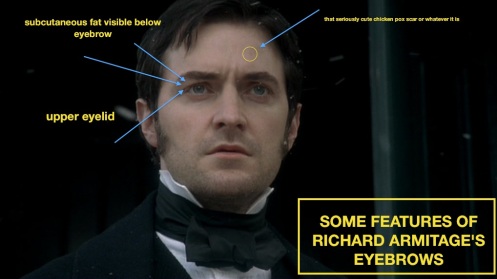 Mr. Thornton (Richard Armitage) looks back at Margaret’s departing carriage in episode 4 of North & South. Source: RichardArmitageNet.com
Mr. Thornton (Richard Armitage) looks back at Margaret’s departing carriage in episode 4 of North & South. Source: RichardArmitageNet.com
At moments of particularly strong emotion, as you remember, the corrugator supercilii drags his eyebrows closer together at the center of his face, pulling the skin over his eyes along with it. The result is a sort of triangular effect at the portion of the eyes nearest the intersection of the glabella of the nose and supraorbital ridge.
We can perhaps see the situation structurally more easily from the side:
 John Porter (Richard Armitage) looks down at his wounded friend in Strike Back 1.1. Source: RichardArmitageNet.com
John Porter (Richard Armitage) looks down at his wounded friend in Strike Back 1.1. Source: RichardArmitageNet.com
This structure and his use of it create an effect that, because it draws part of his eyes into shadow, casts a shadow or throws up a highlight that strongly underlines the emotionality of his face.
Lucas North / John Bateman has it, for instance:
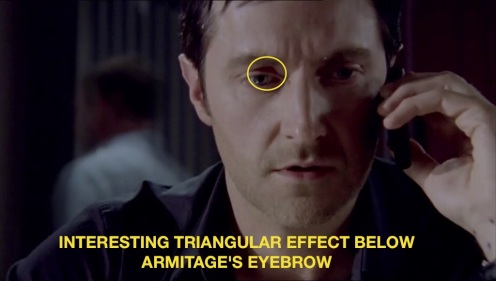 John Bateman / Lucas North (Richard Armitage) reacts to an unwanted phone call from Vaughn in Spooks 9.7. Source: RichardArmitageNet.com
John Bateman / Lucas North (Richard Armitage) reacts to an unwanted phone call from Vaughn in Spooks 9.7. Source: RichardArmitageNet.com
And it’s always an indication of severe pain for Mr. Thornton when it appears:
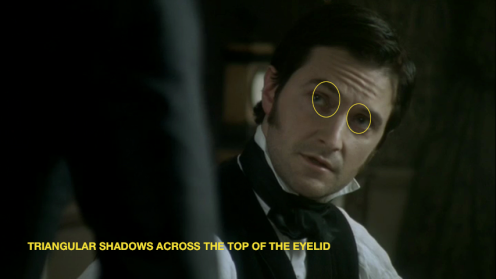 Mr. Thornton (Richard Armitage) asks his mother (Sinead Cusack) if she would have him risk harming others by speculating in episode 4 of North & South. My cap.
Mr. Thornton (Richard Armitage) asks his mother (Sinead Cusack) if she would have him risk harming others by speculating in episode 4 of North & South. My cap.
And see it here, on Heinz Kruger? It’s an effect that is always lessened by circling it, so look for yourself:
 Heinz Kruger (Richard Armitage) surveys the lab before detonating an explosion in a publicity still from Captain America: The First Avenger. Source: RichardArmitageNet.com
Heinz Kruger (Richard Armitage) surveys the lab before detonating an explosion in a publicity still from Captain America: The First Avenger. Source: RichardArmitageNet.com
It is really the appearance of this particular tiny little shadow, along with the judicious employment of depressor angulari oris, that makes Heinz Kruger anything more than a stock villain. He really does look angry, frustrated, desperate sad, and regretful, all at once and Armitage gives him that with his eyes.
I find myself looking for the highlight thrown up by the triangle at particularly emotional moments in his acting, and it is typically not anger that produces this highlight so much as suffering that is tinged with anger or frustration:
 Lucas North (Richard Armitage), feeling betrayed, looks at Sarah after the encounter with Oleg Darshavin in his apartment in Spooks 8.4. Source: RichardArmitageNet.com
Lucas North (Richard Armitage), feeling betrayed, looks at Sarah after the encounter with Oleg Darshavin in his apartment in Spooks 8.4. Source: RichardArmitageNet.com
The above, I think, is part of what fans mean when they talk about his eyes being hooded. The presence of the fold is another line that points to the position of his eyelid. (Although he is also capable of veiling his eyes without closing them, an interesting technique that should be the topic for another post someday. Writing it down.)
Interestingly, the skin over the eyelid is the least fat-padded area on the entire body, although humans can / do, like Armitage, normally have small repositories of fat just below and to the side of the eyebrow as indicated in the diagrams. You’ll guess that I read some plastic surgery sites to write this post, as this particular fold (and aspects of its formation) are affected by aging, and thus are a frequent target of plastic surgery. I also admit that this tissue interests me because I think that the margins of his eyes are the features of his photos most frequently airbrushed, and, I suspect, most heavily made up during shooting.
Armitage always seems to have had this facial feature, even in relatively early photos, where more than the margin of the lateral portion of his eyelid is usually not visible.
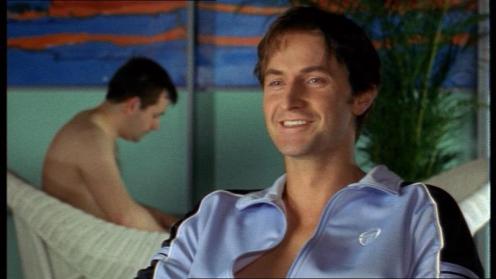 A grinning Lee (Richard Armitage) flirts with Ramona in Cold Feet 5.1. Source: RichardArmitageNet.com
A grinning Lee (Richard Armitage) flirts with Ramona in Cold Feet 5.1. Source: RichardArmitageNet.com
On Armitage the size of the fold varies slightly, due, one suspects, to his level of hydration (really significant for the day to day appearance of the eyes), and it also is slightly affected by his weight. It’s hard to find this effect on the face of John Standring, who has one of the fleshier faces of an Armitage character, despite his frequent consternation. And beginning of Spooks series 7 Lucas North, who has the thinnest face of any Armitage character — Armitage almost managed to diet his cheeks away — often displays an easily visible upper eyelid.
 Lucas North (Richard Armitage) jokes with Arkady Kachimov in Spooks 7.2. Source: RichardArmitageNet.com
Lucas North (Richard Armitage) jokes with Arkady Kachimov in Spooks 7.2. Source: RichardArmitageNet.com
You can see the fold is still there, although it’s not much padded with fat at all. Of course, it’s not that he can’t look emotional without that little fat padding and the shadow created by the muscle pulling it, although the thinner face makes the dramatic shadow smaller.
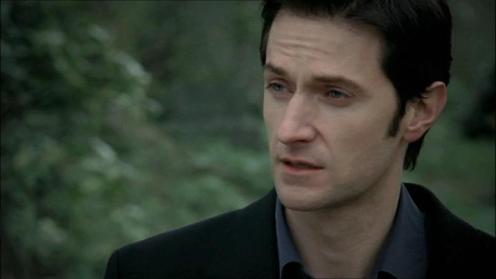 Lucas North (Richard Armitage) responds to Elizaveta’s reassurance directed at his apparent regret at betraying MI-5 in Spooks 7.2. Source: RichardArmitageNet.com
Lucas North (Richard Armitage) responds to Elizaveta’s reassurance directed at his apparent regret at betraying MI-5 in Spooks 7.2. Source: RichardArmitageNet.com
The shadow is perforce much smaller here, but the lack of shadow, along with Lucas’ pallor, creates a feeling of washed-out hopelessness as opposed to the dramatic consternation, underlain with frustration, generated when the shadow is present. The more pronounced sulcuses on both upper and lower eyelids also make him look more childlike and thus more vulnerable.
One consequence of this particular physiological construction around the supraorbital ridge is that indicating strong or forceful emotion in terms of opening the eyes fully requires a really mobile forehead.
 Clearly communicated reaction: Richard Armitage at the first cast press conference for The Hobbit, Wellington, New Zealand, February 11, 2011. Source: RichardArmitageNet.com
Clearly communicated reaction: Richard Armitage at the first cast press conference for The Hobbit, Wellington, New Zealand, February 11, 2011. Source: RichardArmitageNet.com
I mentioned recently that I had asked myself why Armitage has such a well-developed frontalis. I had wondered whether it was due to genetics or if other factors were involved. Examining this tissue construction suggests two plausible explanations. First, we can see from the press conference photo above that if he really wants to show his entire eye construction, because of the position of that fold, he has to shift a big chunk of his forehead territory. Second, these folds under the eyebrow create a potential physiological problem if they grow too large, as I learned from reading about plastic surgery today. If the fold over the lid gets to the point where it’s big enough to start to fall onto the “platform” of the upper eyelid, the brain sends a signal to frontalis to contract in order to lift the fold off of the eyelid. In other words, the existence or prominence of the fold may also be causing the unusually prominent and well-developed frontalis muscle that we notice so often with pleasure. (The reason for plastic surgeons to note this pattern is that eyelid surgery to correct or lessen this fold can thus relax frontalis, thus avoiding the necessity for botoxing to reduce forehead wrinkles and maintain youth even while maintaining an individual’s facial expressiveness. Another potential response to the pattern is surgery to reposition the forehead muscles and thus also change the shape the fold takes, preventing it from falling onto the eyelid. I am emphatically not recommending any of these approaches. This information just offers an additional answer to the question of why his frontalis is so developed.)
 Richard Armitage as Thorin Oakenshield in the initial publicity still for The Hobbit: An Unexpected Journey, revealed in July 2011. Source: RichardArmitageNet.com
Richard Armitage as Thorin Oakenshield in the initial publicity still for The Hobbit: An Unexpected Journey, revealed in July 2011. Source: RichardArmitageNet.com
When the first pictures of Thorin were published, I wrote that I liked the look because I felt it corresponded with the natural architecture of Mr. Armitage’s face. Looking at that first picture above, we can see the way that the built-up supraorbital ridge enhanced the dramatic intensity of his face from a frontal view, with a pronounced, almost threatening shadow emanating from under the brows, though we can’t see anything further than that texturally. It will be interesting to see how this makeup technique ends up working in different lightings of Thorin’s face; Jane is not the only person I’ve heard express concern that the heavy dwarf makeup may conceal some important tools he uses to work his effect.
Initial photos suggest, with regard to this particular case, that the supraorbital ridge may be so built up that in some lights from the front, the effect I am talking about may not be visible at all.
 Thorin Oakenshield (Richard Armitage) and Bilbo Baggins (Martin Freeman) in a screencrap from preproduction vlog #3 from The Hobbit. Source: RichardArmitageNet.com
Thorin Oakenshield (Richard Armitage) and Bilbo Baggins (Martin Freeman) in a screencrap from preproduction vlog #3 from The Hobbit. Source: RichardArmitageNet.com
Given the lack of context, it’s hard to say anything much about these indoor-lit photos, but in all of them his eye shape ends up looking like a much flatter oval than normal. He may also manage something with that, of course, but an initial response is that from that perspective he looks a little unfamiliar. On the other hand, the lateral view gives us a much better sense of how shadow might fall around the supraorbital ridge.
 Richard Armitage as Thorin Oakenshield at far left in screencap from preproduction vlog #3 for The Hobbit. Source: RichardArmitageNet.com
Richard Armitage as Thorin Oakenshield at far left in screencap from preproduction vlog #3 for The Hobbit. Source: RichardArmitageNet.com
From the side, we can get a more familiar glimpse of Armitage’s face and the way that light and shadow play across it.

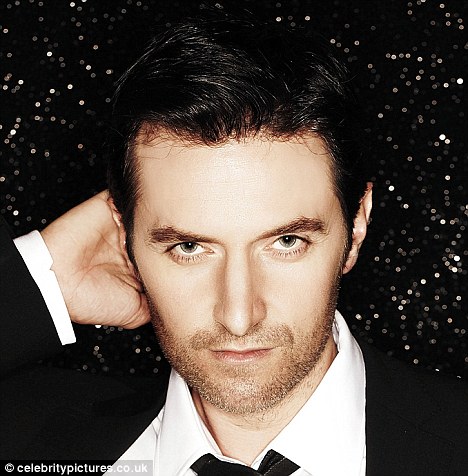


I love these RAnatomical posts, serv, the work you put into them is much appreciated!
BTW, was I supposed to ignore the focused and unfocused stubble in the second pic? *grin*
LikeLike
Understanding that is essential to our analysis of the eyes, I believe (Servetus coughs)
LikeLike
Another enlightening RAnatomical post Servetus, well done. I’m learning all the time being a RA admirer, not wasting time at all. Have you already done his wonderful hands and fingers?
LikeLike
I’ve not done a comprehensive analysis. There are bits and pieces here and there.
LikeLike
Mr. Armitage is fortunate in having exceptional facial bone structure, and a subtle mobility of feature. The working of the suborbital bone with the upper eyelids is remarkable. Often, the eyelids produce a hooded effect, useful for conveying a mystery or ambiguity about the character. In other screencaps, (is it the raising of the brows to bring the forehead into prominence, servetus?) the “hooded” lids are much less in evidence. In that scrrencap of Kruger, I focus on the mouth…
It might be that the prosthetics reduce the power of these elements. Body language and voice will have a role here.
LikeLike
re: mouth — yes, depressor angulari oris 🙂
LikeLike
April Fool! Michael Fassbender..yeah, right…
LikeLike
yeah, I didn’t think I’d con many people 🙂
LikeLike
Yet another fascinating post about RA. I always love these ones. It always confuses my husband (who is a physio) when I mention some random muscle in the face. You can see him wondering where the hell I found out about that. If only he knew …..
Love your new top picture by the way. xxx
LikeLiked by 1 person
the next anatomy post I ahve planned also has to do with a facial muscle, so you’ll have another chance soon 🙂
LikeLike
[…] useful to him as an actor, of course, because it means that even at points where his very prominent supraorbital ridge dominates a facial expression — due in part, of course to lighting — he can still […]
LikeLike
Till you see the whites of Armitage’s eyes « Me + Richard Armitage said this on April 15, 2012 at 4:11 am |
[…] series available, too. For instance, this wonderful lateral view of the structure around his supraorbital ridge vies us a particularly beautiful perspective on his pronounced inferior palpebral sulcus (below […]
LikeLike
When are big files are too big? Richard Armitage and the long-haired co-star « Me + Richard Armitage said this on June 12, 2012 at 9:38 pm |